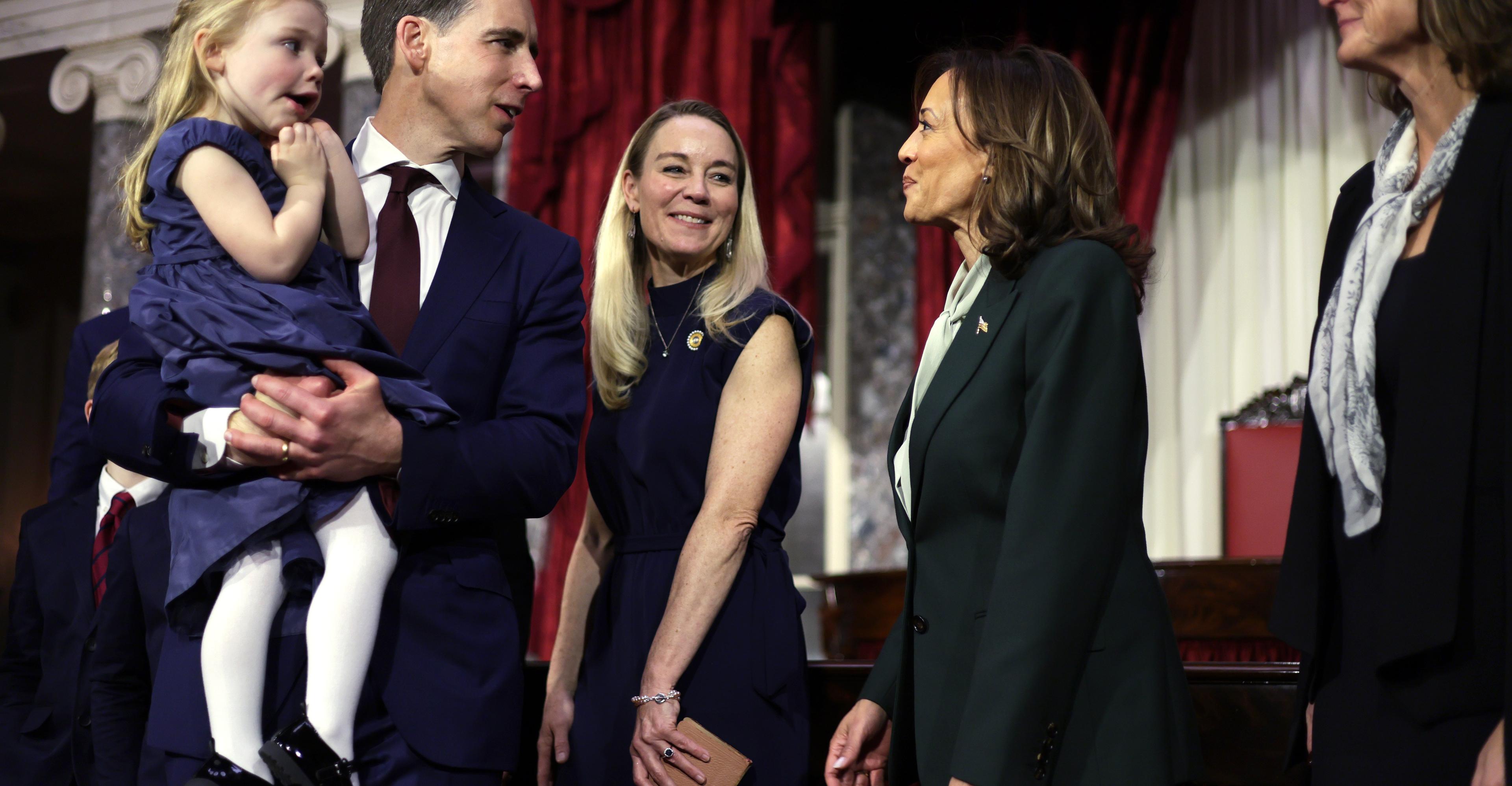Vice President Kamala Harris wants to make housing more affordable — and to help more Americans build wealth by investing in real estate. These are the twin goals of the Democratic nominee’s recently unveiled housing agenda. And they are largely incompatible.…

Published ایک سال قبل on اگست 31 2024، 12:00 شام
By Web Desk

Vice President Kamala Harris wants to make housing more affordable — and to help more Americans build wealth by investing in real estate. These are the twin goals of the Democratic nominee’s recently unveiled housing agenda. And they are largely incompatible. Harris aims to reduce Americans’ housing costs by making residences more abundant: She wants to incentivize localities to allow more multifamily housing construction, open up federal lands for residential development, and provide tax incentives to builders who construct low-cost “starter” homes for first-time buyers. At the same time, Harris has declared that “a home is more than simply a house” as it provides “the opportunity to build wealth.” To help Americans who currently cannot afford to build wealth through homeownership, Harris has vowed to provide first-time homebuyers with up to $25,000 in down-payment support. To expand the number of single-family homes available to families looking to buy, meanwhile, Harris would deny tax benefits to investors who buy large numbers of single-family homes and turn them into rental properties. Much of this platform is laudable. Certainly, Harris has articulated a more coherent vision for cutting Americans’ housing costs than her Republican counterpart has offered. And it is also refreshing to see a Democrat put America’s housing shortage at the center of their campaign: This week, Harris is promoting her plans for achieving housing affordability through a tour of swing states and a new TV ad. Nevertheless, there is a profound tension at the heart of Harris’s agenda, one that reflects the core contradiction in America’s broader housing politics: The easier it is for people to afford housing, the harder it will be for homeowners to build significant wealth through their real-estate investments. To no small extent, Democrats must therefore choose between Harris’s two imperatives: Do they want to make housing more affordable, or ensure that investing in housing is a sound wealth-building strategy? On the merits, there is little question that liberals should prioritize making housing cheaper. There is nothing progressive about putting property owners’ return-on-investment above less privileged Americans’ access to shelter. Further, promoting homeownership as a wealth building strategy also fails many homeowners. Concentrating one’s savings in a single asset is a perilous investment strategy, especially for America’s least privileged groups. Of course, what’s substantively ideal is not always politically wise. And this is especially true in the realm of housing policy. The Democratic Party cannot afford to ignore homeowners’ interests, since they comprise a large majority of registered voters. If Democrats somehow succeeded in making housing so abundant that it tanked home values, Republicans might win California and New York soon after. Still, although tanking home prices isn’t politically tenable, slowing their growth in the name of affordability probably is. And for people looking to buy or rent a home, it makes a big difference whether home values rise faster or slower than wages. If paychecks grow more rapidly than home values, then housing becomes more affordable for workers, even if the nominal price of a house goes up. In that scenario, fewer renters would struggle to keep roofs over their heads, while homeowner backlash to increasing affordability would be limited, since, on paper, houses would appear more valuable than when they were purchased. Pursuing that outcome, however, means making housing a worse investment for new buyers, especially relative to putting their savings into diversified index funds. Democrats therefore should not go out of their way to encourage middle-class Americans to invest in housing. And they certainly should not adopt policies that privilege homeowners over renters. Unfortunately, some aspects of Harris’s housing agenda do both. Some of Harris’s policies put homeowners above renters Through both her rhetoric and her policy proposals, Harris is encouraging Americans in general — and lower middle-class ones, in particular — to build wealth through homeownership. Consider a family that can just barely afford to purchase a starter home. If they choose to plow nearly all their savings into such a property, Harris’s plan would give them $25,000. If they decide to rent and put their savings in the stock market instead, Harris’s agenda would provide them with no comparable cash assistance. Harris’s plan further incentivizes homebuying over renting by deterring large investors from renting out single-family homes, a policy that would expand the supply of housing available to homebuyers at the cost of shrinking the supply available to renters. These are not sound or progressive policies for three reasons. First, they prioritize the needs of homebuyers over renters, despite the fact that the latter are generally less economically privileged. Second, if Harris succeeds in making housing a lot more affordable, then many of the first-time buyers attracted into homeownership will have made an unwise investment. And third, homeownership is a perilous wealth-building strategy for less privileged Americans even today, when prices are high and housing is scarce. To appreciate the inequitable nature of Harris’s plan, consider this: If you are economically secure enough to afford homeownership with a little bit of assistance, then Harris would give you $25,000. If you’re too poor to buy a home even with that aid, her plan would give you $0 in wealth-building subsidies. By contrast, some of congressional Democrats’ ideas for promoting wealth creation — such as “baby bonds,” a program that would provide Americans with a lump sum of investment capital when they turn 18 — do not deny aid to the very neediest. More counterintuitively, it is not necessarily equitable to bar large investors from buying and leasing single-family homes, as such a policy effectively reduces the supply of such housing available to renters. Curiously, Harris’s agenda would allow investors to rent out large numbers of apartments, but punish them if they choose to buy and lease single-family homes. Why should we support corporations expanding the rental stock of apartments, but oppose them increasing that of houses? Put differently, why is there a presumption that homebuyers should enjoy privileged access to single-family homes? I suspect that this assumption reflects the profoundly regressive values that undergird single-family zoning itself: As Dartmouth economist William Fischel has persuasively argued, affluent suburbs first started banning multifamily housing partially in response to the advent of buses, which made it possible for low-income workers to live in their towns. The point of the single-family norm was therefore to keep poor people out of rich areas. When large real-estate holders buy or build such homes and rent them out, they marginally undermine class segregation by making it possible for a group of lower-income workers to pool resources and rent a home in a middle-class area. To be clear, I do not think that reinforcing class segregation is the conscious aim of Harris’s policy. There is a widespread belief among progressive Democrats that large investors buying up homes is a major driver of rent growth. The theory is that when a big corporation owns lots of housing in an area, they have more price-setting power, as there is less competition among different landlords. As an account of why housing costs are high today, however, this is totally implausible. As of 2022, institutional investors owned only 3 percent of all single-family rental units in America. That year, the largest owner of single-family rental homes, Invitation Homes, owned just 0.6 percent of all such houses on the rental market. Monopoly ownership of single-family rental housing cannot be a leading driver of housing costs because it does not exist. Democrats should certainly combat any instance of collusion between landlords, such as that alleged in the lawsuit against property management software company RealPage. And they should also impose stiff penalties on all landlords — large or small — who fail to honor all of their legal obligations to their tenants. But it does not follow that the party should make it harder for renters to find a single-family home to lease by arbitrarily discouraging companies from buying (or building) and then renting out such properties. To make housing affordable, you need to make it a worse investment The second problem with Harris’s plan is that — if the laudable parts of her agenda succeed in making housing more abundant — then many first-time homebuyers will regret investing in a house. After all, housing is only a good investment if its value rises faster than inflation and wages. Otherwise, in real terms, it loses value. If housing becomes more affordable over time, then it becomes a bad investment. It’s true that homeownership can theoretically aid wealth-building merely by forcing workers to save a significant portion of their incomes (since it compels them to dedicate a chunk of each paycheck to paying down a mortgage). But this alone does not make housing a sound vehicle for wealth creation. Between 2011 and 2022, 86 percent of the median homeowner’s gain in housing wealth derived from rising prices, while only 14 percent came from paying down their mortgage, according to a report by the National Association of Realtors. And for housing to become affordable, we need the rate of home price appreciation to slow by a lot. The share of working-class renters who are severely rent-burdened — meaning more than 50 percent of their income goes to housing costs — has nearly tripled over the past two decades to 17 percent, a record high. A massive housing shortage is also elevating costs for those higher up the income spectrum. According to Zillow, the United States currently has about 4.5 million fewer homes than aspiring households. Were that number to fall anywhere near zero, housing would become a drastically worse investment, even as it became much easier and cheaper for tenants and would-be homebuyers to secure. Homeownership is already a risky investment strategy, especially for the disadvantaged Even if Harris fails to make housing more affordable, many Americans would still be better off not tying up their savings in a house. And this is especially true of lower-income and Black Americans. As the Atlantic’s Jerusalem Demsas has written, homeownership is already a perilous financial strategy. It effectively requires households to make an enormous bet on price trends in a single real-estate market. Yet it is difficult for real-estate analysts — much less ordinary working-class families — to anticipate which cities will see their home values rise over a two-decade period, and which will not. Thirty years ago, Cleveland’s home prices were higher than both San Francisco’s and America’s national average. Yet investing in Cleveland real estate in 1994 would have been a bad financial decision. Between that year and April 2024, the typical Cleveland home saw its value grow by 142 percent in nominal terms. Over that same period, by contrast, the S&P 500’s value shot up by roughly 1,000 percent. For affluent households, the unpredictable whims of real-estate markets aren’t that big of a problem. The upper middle-class can afford both homeownership and a diversified portfolio of financial products. Indeed, according to the Atlantic’s analysis of Federal Reserve data, the top 10 percent stores more wealth in stocks and mutual funds than in housing. And this is even more true of the richest 1 percent. But less affluent households can’t buy a home without concentrating their savings in a single asset. Yet it is precisely this population that Harris’s plan is ostensibly trying to nudge into homeownership by subsidizing starter-home purchases. If homeownership is perilous for lower middle-class households in general, this is especially true for Black ones. Houses in communities with large Black populations tend to increase in value at a much lower rate than those in overwhelmingly white communities. This partly reflects the fact that Black Americans are disproportionately economically disadvantaged, but also reflects the persistence of white racism. As Demsas notes, a 2018 Brookings Institution study found that homes in majority-Black neighborhoods are worth 23 percent less than homes in communities with little to no Black residents — even when controlling for amenities (such as school performance, economic opportunity, and crime). Ultimately, the value of a house is determined by the subjective perceptions of homebuyers. In the US, most potential homebuyers are not Black. And Brookings’ research suggests that, whether consciously or not, many white Americans prefer white neighbors to Black ones, and this racial preference ends up getting priced into real-estate values. For this reason, many Black working-class and middle-class households would be better off investing in stocks than a house. When you buy an S&P 500 index fund, the return on your investment will be unaffected by your skin color. White investors do not (and cannot) put a premium on purchasing stocks from other white people. Your pigmentation is not visible on E-trade. Add in that an index fund also diversifies an investor’s risk — effectively allowing them to bet on the future performance of the US economy writ large, rather than, say, the future performance of housing prices in Cleveland — and it seems clear that many Black households are poorly served by homeownership. Of course, the strongest counter to every financial argument against homeownership is that — in today’s economy — renting may be even worse. People need a place to live more than they need safe financial assets. Homeownership eventually enables people to enjoy more affordable and stable housing than they could secure on the rental market. If the alternative to buying a home is being forced to move every couple years as shifting demand prices you out of your neighborhood, then homeownership is liable to make sense from both a financial and quality-of-life perspective. But this is less a good argument for subsidizing home purchases than one for making rental housing cheaper. In a world of abundant rental housing, families will be able to enjoy some of homeownership’s present benefits without its attendant costs. When the supply of rentals is large relative to demand, rental price growth is slow, reducing tenants’ vulnerability to displacement. Unlike homeownership, however, the stability provided by cheap rental housing comes paired with flexibility. Selling a home and buying a new one tends to be more expensive than merely moving. And such costs can make it harder for people to pursue unexpected opportunities or meet emergent needs. Finally, as already noted, in a world where Harris achieves what she promises — and makes housing affordable for renters and buyers alike — most Americans will be better off investing in a diverse array of financial assets than staking most of their wealth on a single piece of real estate. In other words, if Harris genuinely believes that she can actually deliver housing affordability, then she should not encourage lower middle-class Americans to buy a home. The politics of housing in America are bad Roughly 65 percent of American households own a home. And since homeowners vote at a higher rate than renters, they account for even more than 65 percent of the electorate. Clearly, then, Democrats cannot afford to engineer a collapse in housing prices. And even slowing the rate of housing price growth could come at a political cost. A 2023 study found that counties where housing prices rose the most over the four years before Election Day were significantly more likely to support incumbents than counties where home values rose less. Still, making housing more affordable — without making it so cheap that housing prices fall in nominal terms — probably wouldn’t be politically detrimental. Many homeowners are future homebuyers. And some do not live where they would ideally like to, as they were priced out of a more desirable market. If Democrats make it possible for them to afford a condo in their favorite city, they probably won’t be too upset about that. More broadly, making it more tenable for people to move to major cities would increase economic growth and productivity, developments that voters tend to reward. Thus, Harris’s impulse to try to bring down housing costs — without challenging the idea that homeownership should be financially lucrative — is a sound one. And her proposals for increasing housing supply are all commendable. But subsidizing down payments for homebuyers and shrinking the stock of single-family rental properties are neither politically necessary nor substantively worthwhile. If Democrats want to help young people build wealth, they can provide cash grants to renters and homebuyers alike. If they want to reduce the profit margins of corporate landlords, they can erode regulatory obstacles to building, thereby increasing construction and reducing the value of existing rental housing. What they should not do is make American housing policy even more biased against renters, or nudge lower middle-class families into making investments that will only pay off if our nation’s housing crisis never ends. Correction, August 30, 8:30 am ET: An earlier version of this article said that institutional investors own 3 percent of all rental units in America. They own 3 percent of the rental market in single-family homes.
Spinner Rashid Khan to lead Afghanistan in Twenty20 World Cup
- 9 گھنٹے قبل

Zohran Mamdani on his mayoral transition and what comes next
- 21 گھنٹے قبل
World begins to bid goodbye to 2025 with fireworks and icy plunges
- 7 گھنٹے قبل
Russia will win in Ukraine, Putin says in New Year address
- 9 گھنٹے قبل

Turn your PC into a Super Nintendo with Epilogue’s new USB dock
- ایک دن قبل

The year of ‘decentering men’
- 21 گھنٹے قبل
Any breach of territorial integrity to face decisive response, says COAS Munir
- 9 گھنٹے قبل

In America, surviving a disaster increasingly depends on what you can afford
- 21 گھنٹے قبل

Why conservatives should pay parents to stay home
- 21 گھنٹے قبل
NA Speaker, Indian FM meet on sidelines of Khaleda Zia’s funeral in Dhaka
- 9 گھنٹے قبل

GOG’s Steam-alternative PC game store is leaving CD Projekt, staying DRM-free
- ایک دن قبل
14 killed, 20 wounded in bus-van collision in Jhang
- 7 گھنٹے قبل
You May Like
Trending





